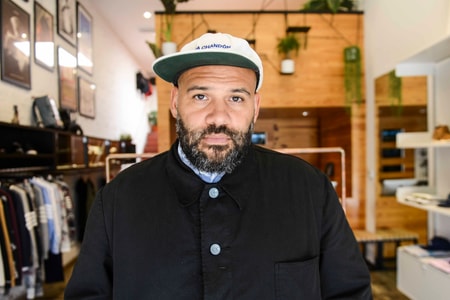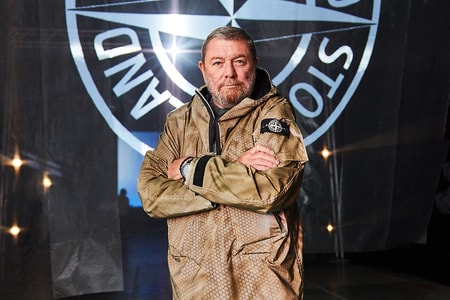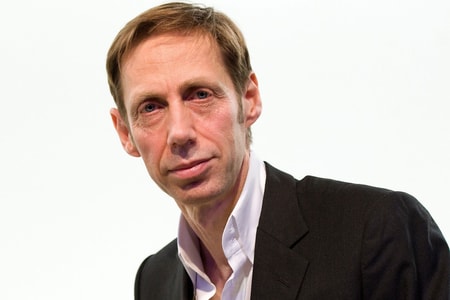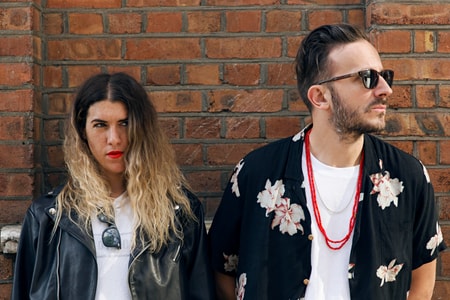
You presented your first runway show this year at London Fashion Week Men's. What does that mean to you in terms of personal accomplishments?
In terms of personal accomplishments it’s really interesting because my aesthetic and intelligence in the world of design pushed me into the fashion industry. It means a lot of old ways in times have changed rules and have become more malleable, and there is really this search for new talent which is very imperative for the future of British design and the way design has helped you go into a wider array of field. It really speaks about the fact that we’re in a place where designers can move across multitudes of different fields professionally.
As demand for your label increases, how are you handling growth?
A lot of sleep might help. We grew to 12 people within one year and I cut it down by six rather than 12. That was really important because having a brand, the output is merely the last phase of the entire machine but really what it is is how the ligaments work together inside the machine—that people don’t see. Now that we are a team of six, we have two studios in East London. When I did my first runway show in January, I was still operating out of my warehouse as a workspace, so now having two studios with a team is truly a testament to the work rate and growth which has just come from a lot of tireless nights and a lot of hard work. Extreme stress at times.
What has been the toughest moment for you this year?
If I was to speak honestly, our collection was supposed to be produced entirely in Portugal and Italy, but the new partnership that we spoke of in regards to manufacturing didn’t work out. So we only had two months to finish a global order of 44 accounts in both the UK and Italy—that was probably the hardest time. It is incredibly stressful if you just went from having half a year to two months to produce a collection locally in a smaller factory.
A-COLD-WALL* is rooted in the idea of Britain's working class. What is the one important thing you want consumers to understand about British culture now?
What I want people to see is the overhanging architectural mood of Britain and London insinuated through the garments and color palettes and narratives that I write. Some of them can be easily digested at surface level and others are quite conceptual and include a very long narrative. What I want to do is to speak to a multitude of consumers at the same time. But for the most part I want people to understand England’s architectural implications from garments and how that affects the socioeconomic side of things and also the melting pot culture London is known for. A lot of times it’s a lot of dense and heavy ideas that are quite abstract, so my job is to present this information in a very digestible and ingesting way.
You spoke about slowing down time in relation to your designs. With fashion trends moving so fast, how do you strategize longevity?
My strategy is to really want to move off calendar and focus on the garments, the products, and the narrative and the execution of designs and ideas and branding—just what I believe is important. Because of the pace at which we move, I’m not really willing to compromise my products to adhere to the timeline which was never inclusive to my idea to begin with. It’s more so I need to adapt to it.
So I’m really, really just trying to focus on the product and the overall execution of ideas and the narrative. That’s my way of combating how the pace of white things move. Because I’m more uncomfortable with why people are digesting and buying so much too—which is another complication. So I’m really trying to step away from that route of having to produce so many goods in such a small amount of time. I’m not really comfortable with that.
You had your first sneaker collaboration with Nike this year. Is there more room for A-COLD-WALL* to collaborate with other labels in the future? If so, with who?
Well, so this is the thing: ACW lives in its own parameters which is very tight, so there are only ever collaborative brands such as Levi’s, Nike and maybe Bang & Olufsen. But for myself, I’m beginning to collaborate with other brands and companies also because as much as ACW has propelled me, I’m also producing contemporary homeware now.
This year I built a lot of strong relationships, such as Takashi Murakami, Daniel Arsham and Hiroshi Fujiwara. So there is almost this exception from the older generation of artists and I’ll be producing a lot of work down that lane. In the future, collaborations may not necessarily align with ACW* but align with my own narrative.
What's your outlook for 2018 and beyond? What are some things you're looking forward to the most?
I feel like I have finally found a home in this community and it is exciting to know that you’re in a stable position now. Now that the brand is stabilized and founded I’m looking forward to a slightly more organized pace at work as I know where I sit in the industry.
I’m just looking forward to more collaboration and peace. I’m kind of looking forward to moving on to the next phase of my career. It’s still a startup company since it’s two years old, but it’s really different compared to when I had to first contact HYPEBEAST and all these other companies. I’m looking forward to having a new sense of maturity that has come about and come with age.









